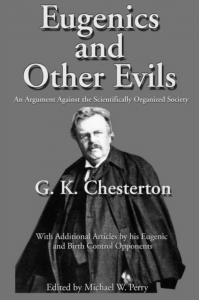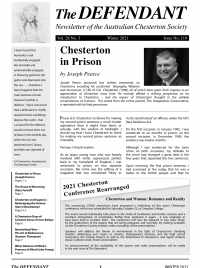The appeal of eugenics – of adapting human beings to the improvements that science might afford – has not disappeared. It remains an underlying issue of current debates about the progressive elimination of human imperfections. Garry Nieuwkamp, a doctor on the NSW Central Coast, reflects on Chesterton’s ideas about this ever-modern debate, encapsulated in Chesterton’s remark that “hope for the Superman is another name for despair of man.” (Maisie Ward, Gilbert Keith Chesterton, 1944)
It was said of St Catherine of Siena that she had a preternatural ability to smell the stink of sin in the air.
Not even the Pontiff in Avignon could escape her olfactory gifts. Pope Gregory XI did not need to hide the corruption in the papal court from Catherine during her visit to persuade him to return to Rome. She could smell it in the air. She could ‘see’ behind the masks. Her followers couldn’t hide their sins from her.
There are times while reading Chesterton that he appears to have a similar gift. With just one inhalation he seems to be able to smell the stench of social evil. And evil is what he smelt in eugenics.

The “tenth-rate professors” and the “bullying bureaucracy” who had gone to war with the “older culture of Christendom” may have had entirely humane and innocent intentions of breeding better people, but as Chesterton wrote, “Eugenics is a thing no more to be bargained about than poisoning”.
From our vantage point, it is difficult to imagine that there was a time when eugenics was almost universally supported and accepted. Presidents, professors, authors, academics, newspaper proprietors, politicians – all could see the benefits of clearing out what they believed to be a declining gene pool. No corner of the globe was exempted from this enthusiasm.
Nothing ever sounds more convincing than a half-baked scientific theory in its adolescent phase. The promiscuous mix of poorly understood Mendelian inheritance with the new chat about finch beaks in the Galapagos ensured that theory (such as it was) could only ever translate into dodgy practice.
Armed with a copy of Darwin’s new thesis under the arm, the eugenicists set about cleaning up “defective humans” and regulating the national stock of “germplasma”. The “feebleminded” had no say in the matter.
Chesterton was having none of it either. For him, “the founding of a family is the personal adventure of a free man”, and ought be outside the frontiers of the State. Scientists and politicians were reaching far beyond their role.
Although commenced earlier, Chesterton’s Eugenics and other Evils was published in 1922, the same year as Ulysses, the more famous book by Joyce. Clearly society was on the move.
Efforts were made during the 1920s to legislate “defective germplasm” out of existence. Experts in animal husbandry simply applied their expertise to human husbandry.
Yet here’s a problem – “the decline of the national stock”, as noted by Adam Cohen in his book Imbeciles (1916). Who is causing the problem? Well, “defective” people. And who are they exactly? Well, those whom the experts diagnose as imbecilic, feeble-minded, epileptics, inebriates, criminalistics, and other degenerate persons.
Throw into that mix southern European immigrants, and one gets an idea of how vast the “problem” was conceived to be. And how might they be stopped from breeding? Well, one could lock them up during their reproductive years. That would work, and it did, but it’s expensive. How about sterilising them? Even better! Not only would it be cheaper, everyone could feel they were acting in the victim’s best interest. After all they wouldn’t have to be held for all of those years. They could be free. Sterile but free! They’d be doing the victim a favour.
Chesterton, of course, saw a problem here. How exactly do you diagnose an imbecile? As it turns out, not very exactly!
A Red Cross nurse had been encouraged to diagnose Vivian Buck at six months of age as “a little odd”. And so sandwiched between two generations of “imbeciles” – her mother and her daughter Vivian – Carrie Buck, only a teenager but with an illegitimate child, became the focus of the Supreme Court of America in Buck v Bell in 1927.
She herself had been diagnosed as a middle-grade moron, by a test that was designed to identify children who needed extra help in class. It wasn’t developed as a diagnostic tool. In any case, contrary evidence that she functioned well at school was conveniently overlooked.
Also overlooked was the fact that when the test was applied on a large scale to US army enlistees, as noted by Adam Cohen, “fully 47.3 percent of the white test takers were feebleminded”, which ought to have caused a group rethink by those applying the test.
By the logic of the test, their country was being defended by a “nation of morons”. Carrie Buck might have expected the highest court in the land to protect her from those with an interest in her reproductive abilities, but one of the greatest minds in the history of the Supreme Court of America, Oliver Wendell Holmes Jr, was having none of it.
“Three generations of imbeciles are enough,” he argued.
And so Carrie Buck underwent what was euphemistically
called the “Mississippi appendectomy”, with the imprimatur
of the Supreme Court. “The principle that sustains
compulsory vaccination is broad enough to cover cutting
the fallopian tubes,” Holmes argued. She apparently
“consented” to being sterilized, believing that those who
represented her had her interests at heart. That the test
which led to her mutilation was next to useless, is
evidenced by the fact that in labelling Carrie Buck an
imbecile, the Court had dropped her down a diagnostic
category from moron to imbecile, and by doing so
substituted their judicial gowns for the diagnostician’s lab
coat!
The consequences of this judicial imprimatur of forced sterilisation was to have unforeseen consequences. They always do. Again Chesterton recognised the danger.
Those who wish to implement eugenic legislation as ‘”an honest attempt” to deal with a great evil’, he writes, ought to make an honest attempt at knowing what they are doing. No one has a bird’s eye view; so a bit of legislative humility might have been appropriate, considering the risks.
In any case, for Chesterton, they are solving the wrong problem. He would almost certainly have been aware of Dr Halliday Sutherland’s battle to unmask Dr Marie Stopes’ eugenic agenda in the UK. The solution to poverty, according to Stopes and her many famous supporters, was to breed the poor out of existence by contraception. Prevention is better than cure, as the homespun wisdom would have us believe. But is it? Prevention, Chesterton argued, amounts to “treating all people who are well as if they were ill”.
Besides, health is simply Nature and by that is meant God’s “mystical and multitudinous balance of all things”. “There cannot be such a thing as a health advisor of the community, because there cannot be such a thing as one who specialises in the universe”.
Unlike health however, Capitalism is a human invention. The best that can be said for it is that it is ‘a corrupt prison’. Solve that problem, and you’ll solve the problem of poverty and hence the need for eugenic solutions. Chesterton’s arguments against Capitalism will not be convincing to everyone, but he is most certainly right about the animus that motivates the eugenicists. “They cannot define who is to control whom; they cannot say by what authority they do these things. They cannot see the exception is different from the rule – even when it is a misrule, even when it is an unruly rule”. If you can’t define the rule and the exception, you can’t diagnose the patient. “The sickness or soundness of a consumptive may be a clear and calculable matter”, he writes, “but their happiness is not calculable at all”.
There is something about human dignity that can’t be got at by a measuring rule. Chesterton could almost have been thinking of Blessed Margaret of Castillo, who was effectively canonised by Pope Francis very recently. Born in 1287, blind and with curvature of the spine, she was abandoned by her parents who initially imprisoned her for years as a kind of embarrassment to their dignity. Eventually, adopted by the Dominicans, she led a life of holiness caring for the sickanddying,herdisabilitybeingasourceofgreatstrength. Her parents had the eugenicist’s animus, but thankfully not their technology.
We may have left forced sterilisations behind, at least in the West in recent years, but we haven’t given up the eugenics project.
Today’s neo-eugenicists clutch at the same old fears, but they have at their disposal greatly enhanced technology. Our dire predicament, according to Ingmar Persson and Julian Savulescu, has created a need for “moral bioenhancement”. In their minds, we are all Carrie Bucks!
But as Chesterton would have asked, who made them the specialists of the universe?
